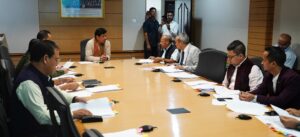SHILLONG, SEPT 6: The primary census data of 2011 has shown that the number of agricultural labourers has dwindled from 17.7 per cent in 2001 to 16.7 per cent in 2011.In absolute terms, the number of agricultural labourers in 2011 was 1,98,364 (rural: 1,92,23, urban: 6,141) which works to 16.7 per cent. While giving a presentation on economic activities and work participation data of census during the workshop on data dissemination of population enumeration census 2011 for Meghalaya on Friday, Census Operations Assistant Director Dr B Das Gupta said that the number of cultivators has declined from 48.1 per cent in 2001 to 41.7 per cent in 2011. The state recorded a total number of 4,94,675 cultivators in 2011 (rural: 4,86,320, urban: 8,355).
Interestingly, nearly 80 per cent of the state’s total population is located in the rural areas.
As per the data, Gupta said that rural population has increased from 78.9 to 79.9 per cent at the state level while urban population has declined by 1 per cent in the 2011 census as compared to the 2001 census.
Meanwhile, the State has seen a decadal change of 28.3 per cent in terms of the Scheduled Tribe Population in 2011 as compared to the 2001 census.
As per the primary census data 2011, Ri-Bhoi recorded the highest decadal change in the Scheduled Tribe population with 37.1 per cent, while West Garo Hills recorded the lowest decadal change with 22.6 per cent.
The decadal change of the Scheduled Tribe (ST) population in other districts of the state were 25.2 per cent in East Garo Hills, 27.5 per cent in South Garo Hills, 29.3 per cent in West Khasi Hills, 29.1 per cent in East Khasi Hills and 31.0 per cent in Jaintia Hills.
As per the primary census data 2011, the total population of Scheduled Tribes in Meghalaya is 25,55,861 with 12,69,728 males and 12,86,133 females.
The district wise ST population is: West Garo Hills (4,74,009), East Garo Hills (3,05,180), South Garo Hills (1,34,237), West Khasi Hills (3,75,097), Ri-Bhoi (2,30,081) East Khasi Hills (6,61,158) and Jaintia Hills (3,76,099).
Meanwhile, the Scheduled Caste (SC) population in the State has also slightly increased in the 2011 census as compared to the 2001 census.
As per the primary census data, the percentage of SC population in relation with that of the total population of the state is highest in East Khasi Hills with 0.7 per cent.
The percentage of SC population out of the total population in other districts are: West Garo Hills (0.4 pc), East Garo Hills (0.2 pc), South Garo Hills (0.2 pc), Ri-Bhoi (0.2 pc), Jaintia Hills (0.1 pc) and West Khasi Hills (0.0 pc).
The total population of Scheduled Caste in the State is 17,355 with 9157 males and 8198 females.
Meanwhile, Gupta also mentioned that the work participation in household industries has declined in almost all the districts in both the urban and rural areas.
Gupta said that the total percent of workers in the household industries was 0.9 percent in 2001 and now it has come down to 0.7 percent in 2011.“The figures is comparatively very low in all the districts with the lowest in East Khasi Hills with a total percentage of only 0.4 percent (0.5 percent in urban and 0.4 percent in rural),”he said.
According to Gupta, the work participation in Meghalaya has also declined in all districts.Comparing to the figures in the 2001 census, he said that the percentage of agricultural labourers to the total population as per the figures in the 2011 census has also reduce drastically.
Informing that in 2001, the percentage of agricultural labourers in the state was 7.5, Gupta said that the present percentage of the agricultural labourers in the latest census is only 6.7 percent.As per the figures, he said that the lowest number of agricultural labourers is in South Garo Hills with a percentage of only 3.9 percent while the highest percentage of agricultural labourers is in West Khasi Hills with 9.7 percent.-By Our Reporter
























+ There are no comments
Add yours